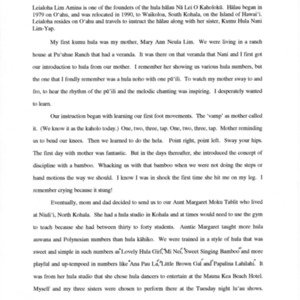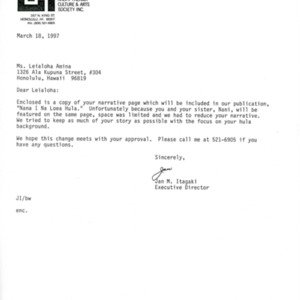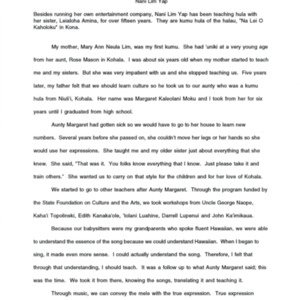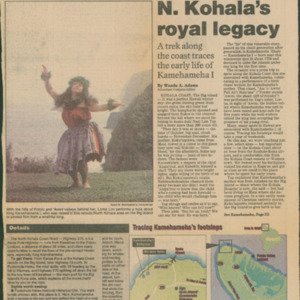Leialoha Amina and Nani Lim Yap
Title
Subject
Description
Leialoha Amina
Leialoha Amina resides on O‘ahu and travels to the Big Island to instruct at the hālau with her sister Nani Lim Yap.
My first kumu hula was my mother Mary Ami Neula Lim. It was on our veranda that Nani and I first got our introduction to hula. She showed us various hula numbers but the one that I fondly remember was a hula noho with one pūʻili. To watch my mother sway to and fro, to hear the rhythm of the pūʻili, and the melodic chanting was inspiring. I desperately wanted to learn.
The first day with Mother was fantastic. But in the days thereafter she introduced the concept of discipline by whacking us with a bamboo when we were not doing the steps or hand motions the way we should. I know I was in shock the first time she hit me on my leg. I cried because it stung!
Eventually Mom and Dad decided to send us to our Aunt Margaret Moku Tahlit. She had a hula studio in Kohala and at times would need to use the gym to teach because she had between thirty to forty students. Her forte was not hula kahiko so she encouraged her students to learn from other instructors. Her first recommendation was to take a six- week hula kahiko workshop from ʻIolani Luahine. Attending that workshop had such a profound effect on me and has been a major contribution to the form of hula you see in our hālau.
The workshop began by Auntie ‘Iolani introducing herself. She then prepared to dance the first number we would learn, “Aia Lā ‘O Pele.” She stood there with a searching look in her eyes as if trying to see something. I remember building up with anticipation to see her dance as she held that stance for what seemed like minutes. Finally she signaled with a finger to the ho‘opa‘a to begin. I watched her transform before my eyes from a little sweet-talking, gray-haired Hawaiian lady to the most graceful moving, story-telling hula dancer. Her eyes and facial expression along with her body movements told you the story of Pele. It was as if her feet were not touching the ground. I felt an energy from her that had me totally captivated. That experience has been with me until this very day.
Since that time I went through a transition period from being the dancer to becoming an instructor. I was asked by Lydia Kauakahi to help instruct her haumāna for the Kualoa Hula Kahiko Competition. I solicited the help of Darrell Lupenui and together we prepared the hālau of students from Nānākuli High School. That was my first introduction to hula competition as an instructor.
Shortly after I was introduced to Pilahi Paki by Uncle Moe Keale and his fiancee Kolena. My focus was moving towards understanding and translating mele. Auntie Pilahi reached into my very soul and has been the turning point in my life in everything that I do. I studied with her for two years and before the ending of the second year, I was blessed by her with my inoa Hawai'i, “Leialoha, “ and with her olioli aloha as a kuleana that I carry to this day. Through a dream she had of seeing beautiful holokū dancing, the hālau was bestowed with the name Hālau Nā Lei O Kaholokū. The olioli aloha has a powerful spiritual message which is the very foundation of Hālau Nā Lei O Kaholokū. The very first assignment for each of our haumāna has been the translation of this olioli and it is the message within the olioli aloha that is within each of us in the hālau.
Hālau Nā Lei O Kaholokū is a culmination of the experiences of my sister Nani and Lorna our alaka‘i, and myself . We feel truly blessed that in our lifetime we have met instrumental people who have shared the art of hula with us. We are always mindful that we carry a responsibility because what we instruct today will have a profound effect on tomorrow. It is our hope that we have done and will continue to do justice to our ancestors by the hula we portray through our hālau.
Nani Lim Yap
In addition to running her own entertainment company, Nani Lim Yap has been teaching hula with her sister Leialoha Amina for over fifteen years.
I was six-years-old when my mother Mary Ann Neula Lim began to instruct my sisters and me. She soon became impatient with our progress and decided to stop teaching. Five years later my father felt that we should not be deprived of learning our culture so he took us to his cousin who was a well-known kumu hula from Niuli‘i, Kohala. Her name was Margaret Kaleolani Moku and l took from her for six years.
Aunty Margaret taught and shared with us her unique style of hula which came from Kohala, Hawai‘i. We met once a week at the old Hāwī Gymnasium for hula classes. After awhile Aunty Margaret fell ill and we travelled to her home to learn new numbers. I enjoyed the stories as well as the hula lessons on the porch of her hale.
Aunty Margaret had difficulty with her legs and became confined to a wheelchair hut she would still continue to dance and teach using her expressions and her hands. The essence portrayed without the movement of her feet was very captivating to me. She taught my older sister and me just about everything that she knew. She said, “You know everything that I know. Just take it and train others.” She wanted us to carry on the style for the children and her love of Kohala. She made sure to share this kideana with my parents as well and to know that it was given with her aloha.
We were encouraged to go to other kumu hula while under her tutelage and also after she had passed on. Through the program funded by the State Foundation on Culture and the Arts, we were exposed to the stvles of "Iolani Luahine, George Na‘ope, Edith Kanaka‘ole, Kaha‘i Topolinski, Darrell Lupenui, and John Ka‘imikaua. These workshops were all deeply appreciated and enjoyed.
Because our babysitters were our grandparents who spoke fluent Hawaiian, we had come to understand ka ʻolelo Hawai‘i. My grandfather came from Kau and spoke a very poetic dialect of Hawaiian. This enabled us to understand the essence of the mele being taught while we were training for hula. When I began to sing, it made the translation even easier. I could understand the song and its literal translations as well as its kaona.
I felt that through that understanding, I should share the knowledge with others. It was a follow-up to what Aunty Margaret had said. This was the time. And so we took it from there, knowing the mele, translating them, and sharing it till today. We have a kuleana to pass on these traditions as they were taught to us and to perpetuate a style that is truly part of Kohala.
Nana / Na Loea Hula 13


















